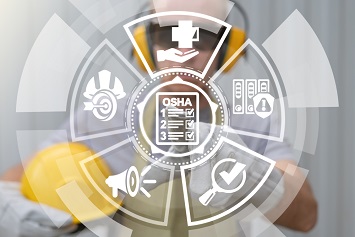The Occupational Safety and Health Administration (OSHA) sets and enforces safety standards for the workplace. It’s a simple job description but a huge undertaking. And given that negative attitudes toward the agency are pervasive among U.S. employers and workers, OSHA’s authority has taken on an almost mythical quality, and many misconceptions about the agency’s powers remain.
It’s not just negative attitudes toward OSHA that affect how your program is managed, though. Even positive misconceptions need to be corrected if they’re leading you to waste time and energy on the wrong things. Let’s bust a few enduring OSHA myths.
Myth 1: True Compliance Is Impossible Due to the General Duty Clause
While many see the General Duty Clause as a catch-all under which inspectors can fine you for almost any general safety violation, the clause only requires you to remove recognized hazards that pose a risk of serious injury or death to your employees.
To cite you under the General Duty Clause, the inspector has to demonstrate that a hazard exists and that no other safety standard applies. This is complicated and time consuming for the agency because the Area Director is required to review all proposed Section 5(a)(1) violations. However, if the hazard is serious, recognized, and able to be corrected, they will cite you.
To bust this myth, release your employees from the pressure to immediately correct the smallest of potential hazards. Instead, assess your overall operations and safety practices, and implement the programs required to control serious risks, such as lockout/tagout and machine guarding for a manufacturing company.
Myth 2: If I Invite OSHA to Inspect My Business, I Will Be Immune to Citations
If you invite OSHA to inspect your business, it will send a consulting team, not an inspection team. Any potential violations will be noted by the consultation inspector, and your company will be expected to correct them. However, if you fail to correct the hazards identified during your consulting audit within the deadline provided, OSHA can (and will likely) still cite you.
OSHA may also conduct a compliance audit if a complaint is filed or a serious incident occurs at the facility, regardless of your having worked with the consultation section.
It’s still a great idea to invite OSHA to inspect your company, especially if your workers regularly assume fall risks by working on ladders, scaffolding, or rooftops. Bust this myth by taking the inspectors’ reports seriously and improving worker safety.
Myth 3: OSHA Prioritizes Large Companies
It can be true that with large companies, more employees are likely to be at risk when a safety concern is present. Therefore, if OSHA prioritizes inspecting a large company, it’s because of the perceived level of risk, not the size of the company alone.
OSHA inspections follow a hierarchy based on what type of workplace hazard has been brought to the agency’s attention. The hierarchy is imminent danger situations, severe injuries and illnesses, worker complaints, referrals, targeted inspections, and follow-up inspections. So, a small company presenting an imminent threat will always be higher on the list than a large company without one.
To bust this myth, remember that OSHA citations of large and recognizable companies are more likely to make the news. Any place can get inspected and cited if it has a fatality, a serious injury, or an imminent threat to workers in its offices, factories, or jobsites.
Myth 4: OSHA Inspectors Will Enforce Our Written Safety Policy
Totally false! OSHA inspectors can only enforce violations of OSHA Health and Safety Standards that apply to your work situation and/or Section 5(a)(1)—they won’t even enforce standards written in OSHA publications.
To bust this myth, improve your safety policy with additional consensus standards provided by the American National Standards Institute (ANSI), the National Fire Protection Association (NFPA), or the American Society of Safety Professionals (ASSP)—and don’t sweat it.
Myth 5: If OSHA Comes to Inspect You, Employees Should Stop Working
This tongue-in-cheek joke has turned into a jobsite myth in some circles. Yes, you may refuse to allow a site inspection without a warrant, and it’s smart to escort the inspector to applicable areas of your worksite. However, if you order your employees to stop working during an inspection, you risk legal repercussions that may include criminal charges or additional fines. OSHA investigators must verify that workers are safe during an on-site audit.
If you know roughly when the inspector is coming (although the vast majority of inspections are unannounced), it’s a good idea to perform a preinspection of your own to make sure no obvious unsafe conditions are present. Provide training for your workers on what to do in the event of an inspection, and ensure they understand that they should cooperate and answer an inspector’s questions truthfully. Employees also have the right to speak with the inspectors privately if they request to without fear of retaliation from the company.
Myth 6: You Should Place Incidents That Required First-Aid Treatment on Your OSHA 300 Log, Just in Case
OSHA recordkeeping rules stipulate that serious work-related injuries, such as death; injuries requiring days away from work (when ordered by a doctor), restricted work, or a transfer to another job; or loss of consciousness, be recorded on the OSHA 300 log. Also, any injury requiring medical treatment beyond first aid must be recorded. However, minor injuries requiring basic first aid are exempted from recording—and you may be cited with a de minimis violation if you record them anyway.
Understand how OSHA defines first-aid and recordable injuries here.
Myth 7: OSHA Is Funded by Penalty Fines, or Inspectors Have a Citation Quota
Since OSHA’s federal budget cut made the news in 2017, this myth has become less pervasive. Even so, it’s still tempting to believe inspectors have an incentive to find as much wrong with your worksites as possible. Actually, any funds generated from enforcement actions go to the U.S. Treasury, and OSHA’s budget is set by Congress.
Bust this myth by reminding yourself and your team that OSHA inspections primarily occur when there is a report of imminent danger or there has been a fatality or multiple recordable serious injuries. When viewed through that lens, it makes sense as to why inspectors would be thorough during an inspection—lives are on the line.
Myth 8: OSHA Will Cite the Temp Agency or Contractor, Not My Company, for Violations Involving Temp or Contracted Employees
Although companies that use temporary workers can avoid some of the hiring requirements and Human Resources paperwork that go along with “direct hire” employees, OSHA compliance and recording of work-related accidents are the responsibility of the company directing the employees’ work.
According to OSHA, “Temporary staffing agencies and host employers share control over the worker, and are therefore jointly responsible for temporary workers’ safety and health…. Therefore, it is essential that both employers comply with all relevant OSHA requirements.”
When you take on temporary hires, ensure they are trained, well-supervised, and included in all aspects of your safety program.
Myth 9: We Need OSHA-Certified Training and PPE to Be Compliant
OSHA requires site- or job-specific worker training to comply with certain safety standards like hazard communication, emergency action plans, forklift operations, etc. However, OSHA does not specifically certify one training class or training provider over another.
The same is true for personal protective equipment (PPE) and other types of safety equipment like fall prevention harnesses. OSHA adopts guidelines established by standard-setting organizations such as the ANSI and NFPA to set testing and performance requirements for manufacturers to follow. As standards change, OSHA enforces them to ensure the latest, best materials and techniques are used in the workplace to provide maximum employee safety.
Myth 10: OSHA Can Shut Down Worksites and/or Order Arrests
This isn’t exactly a myth. OSHA technically can do both of those things but only under very specific circumstances. Although an OSHA inspector can halt or pause operations when an imminent danger situation exists (such as finding workers in an unprotected trench), total shutdowns happen extremely rarely and require a court order.
It is also not likely that OSHA would initiate arrests during or after a facility inspection. OSHA is required to refer cases of a suspected criminal nature (usually criminal negligence that leads to a fatality or major incident) to the U.S. Department of Justice for action. Inspectors don’t have the authority to make arrests.
Shift Your Thinking and Transform Your Safety Program
Today, most business owners have realized safety is not a productivity hang-up. It’s a vital workplace system that should be fully integrated into project management processes and technology.
Having an effective safety and health program saves money by preventing accidents that stop production and injuries that lead to lost productivity and huge hospital and insurance costs. Likewise, OSHA is not the faceless enforcer of pointless rules—it’s the guardian of commonsense safety practices in the United States.
 David Paoletta, MS, MBA, CSP, CUSP, is a research analyst and subject matter expert for Safesite, a safety management software company based in San Francisco, California. He is also a principal consultant with New Dimensions in Safety in Alameda, California. David Paoletta, MS, MBA, CSP, CUSP, is a research analyst and subject matter expert for Safesite, a safety management software company based in San Francisco, California. He is also a principal consultant with New Dimensions in Safety in Alameda, California.
David has extensive utility field safety experience with PG&E in California and PNM Resources in New Mexico, including electric distribution and power plant operations. He was the subject matter expert at the NASA Ames Research Center in Mountain View, California, on both Electrical Safety and Hazardous Energy Control (LOTO) Programs. David has managed safety programs in manufacturing (Moore N.A. and GE), for the city of Santa Fe, and with Chugach Management Services, an Air Force contractor. He is a past New Mexico American Society of Safety Engineers (ASSE) SPY Award winner and a past President of the San Francisco Chapter ASSE. He is a certified safety professional (CSP) and a certified utility safety professional (CUSP) and holds an MS in Occupational Safety Management and Industrial Safety from CMSU. You can read more of David’s safety management insights on the Safesite blog. |


